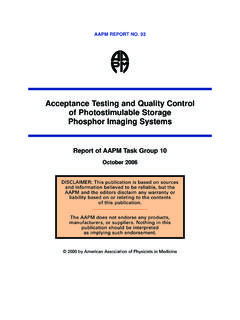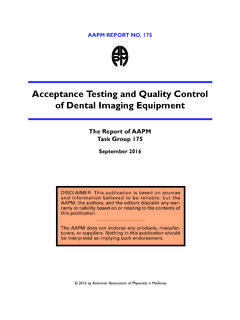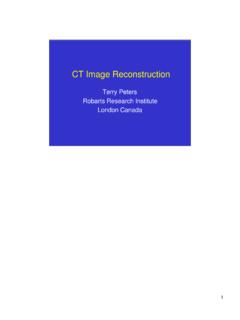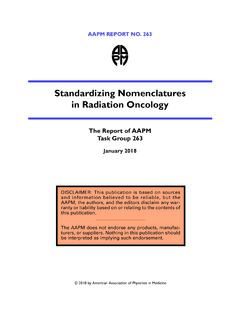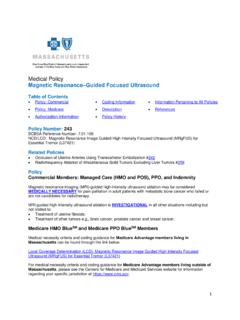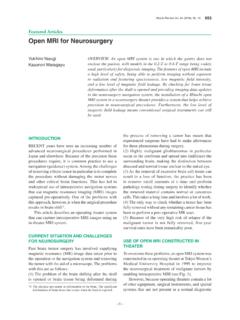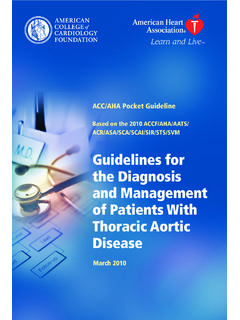Transcription of AcceptanceTesting andQualityAssuranceProcedures ...
1 AAPM REPORT NO. 100 AcceptanceTestingand Quality Assurance Proceduresfor Magnetic Resonance Imaging FacilitiesReport of MR Subcommittee Task Group IDecember 2010 2010 by American Association of Physicists in MedicineDISCLAIMER: This publication is based on sourcesand information believed to be reliable, but theAAPM, the authors, and the editors disclaimany warranty or liability based on or relatingto the contents of this AAPM does not endorse any products,manufacturers, or suppliers. Nothing inthis publication should be interpretedas implying such : This publication is based on sources and information believed to be reliable,but the AAPM, the authors, and the publisher disclaim any warranty or liabilitybased on or relating to the contents of this AAPM does not endorse any products, manufacturers, or suppliers.
2 Nothing in thispublication should be interpreted as implying such : 978-1-936366-02-6 ISSN: 0271-7344 2010 by American Association of Physicists in MedicineAll rights byAmerican Association of Physicists in MedicineOne Physics EllipseCollege Park, MD 20740-3846iiiEdward F. Jackson1 Department of Imaging Physics, The University of Texas Anderson Cancer Center,Houston, TXMichael J. BronskillSunnybrook & Women s College, Toronto, ON, CanadaDick J. DrostNuclear Medicine and MRI Department, St Joseph s Health Centre, London, ON, CanadaJoseph OchMedical Physics and Engineering, Allegheny General Hospital, Pittsburgh, PARobert A.
3 PooleyMayo Clinic, Jacksonville, FLWlad T. SobolRadiology Department, The University of Alabama Birmingham, Birmingham, ALGeoffrey D. ClarkeDepartment of Radiology, The University of Texas Health Sciences Center, San Antonio, TXSubmitted to MRSC reviewers on:August 11, 2008 Approved by the MRSC reviewers on:September 9, 2008 Submitted to IPC on:November 25, 2008 Approved by the IPC on:Spring, 20091 Address correspondence to: Edward F. Jackson, of Imaging Anderson Cancer Center1515 Holcombe Blvd, Unit 1472 Houston, TX (FAX)Key Words:MRI, Magnetic Resonance Imaging, Acceptance Testing, Quality AssuranceMR SubcommitteeTask Group IContentsI.
4 1II. Acceptance Test Procedures Prior to MR System 3A. Vibration 3B. RF Shield Testing .. 3 III. Acceptance Test Procedures Following MR System 5A. Magnetic Fringe Field Mapping .. 5B. Phantoms .. 6C. MR System 7D. General System Checks .. 7 Mechanical System 7 Emergency System 8 Patient Monitoring, Anesthesiology Systems, Gating Systems,and MR-Compatible 8E. MR Scanner System 9 Static Magnetic Field Subsystem 9RF Subsystem 13 Gradient Subsystem 14 Combined Gradient/RF Subsystem 16 Global System 17F.
5 Advanced MR System Tests .. 23 Ultrafast Imaging 23 Spectroscopy 27IV. 31v1I. IntroductionThis document was prepared to assist the medical physicist in defining an acceptance teststrategy and quality assurance procedures for magnetic resonance imaging (MRI) to the wide variety of MRI systems available, with an equally wide range of options oneach type of system, this document does not seek to provide a definitive guideline for devel-opment of such procedures. Instead, the goal of this document is to provide suggestions forrelevant, practical tests that qualified medical physicists can perform independently or withthe assistance of the magnetic resonance (MR) system vendor s service personnel.
6 The docu-ment outlines a recommended general testing strategy, overviews phantom availability/preparation issues, and then lists individual tests, each with a rationale for performing the test,a suggested procedure, and, where appropriate, suggested acceptance criteria. In some cases,alternative procedures are also document was developed to replace the now dated reports of the AmericanAssociation of Physicists in Medicine (AAPM) Magnetic Resonance Task Group 11and TaskGroup 62, although some materials from these original reports are referenced in the currentdocument.
7 This document also refers to specific tests and acceptance criteria based on theAmerican College of Radiology (ACR) MR Accreditation Program MR phantom testing doc-uments3,4and the ACR MRI quality control (QC) program rationale forspecific inclusion of selected ACR phantom tests was made based on the large number ofACR-accredited MR facilities and, therefore, the widespread availability and use of the ACRMR Accreditation Phantom. For ACR phantom tests, it should be noted that some acceptancecriteria given in this document differ from action criteria noted in theACR MR Quality ControlManual 20045and/orMRI Phantom Test Guidance4document.
8 In such cases, the criteria rec-ommended herein exceed the requirements suggested by the ACR, as acceptance testingshould establish the optimal operating characteristics for the MR , the earlier the medical physicist becomes involved in the installation processthe better. Ideally, the physicist will be involved in the bid specification and review process,the purchase decision, the site planning and construction meetings, and the testing of theradiofrequency (RF) shielding. In addition to the actual performance of the acceptance tests,the development of the system specifications, the testing and acceptance criteria, and thereview of the service contracts are all areas where medical physicist involvement is highlyadvised.
9 Without involvement at these early stages, mutual agreement between the site and thevendor regarding specific tests and acceptance criteria can be difficult, if not impossible, toobtain. Site planning requirements for MR systems include aspects quite unique as comparedto requirements for most other imaging modalities, particularly with respect to safety, vibra-tion, magnetic field shielding, and RF interference shielding. It is strongly recommended thatthe physicist carefully review site planning information contained in the pre-installation man-ual for the specific system under discussion (now generally available online) as well as theACR Guidance Document for Safe MR Practices.
10 Reference information isavailable in the 1992 AAPM Summer School , the level of rigor in acceptance testing of MRI systems is highly variable,ranging from acceptance based on first patient examination, with no involvement of personsother than the vendor s service/installation personnel, to highly rigorous acceptance testingACCEPTANCE TESTING AND QA PROCEDURES FOR MRI FACILITIESAAPM REPORT However, several changes in the clinical practice of MRI are causing the MR com-munity to re-evaluate the prior and current levels of acceptance testing and quality assuranceprograms.
